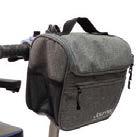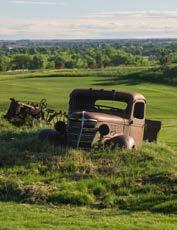

mobility scooter with anti-tip technology







Like millions of older Americans, I struggle with mobility. For years, I watched my quality of life slip away, as I was forced to stay home while friends and family took part in activities I’d once enjoyed. I thought I’d made some progress when I got a mobility scooter, but then I realized how hard it was to transport. Taking it apart and putting it back together was like doing a jigsaw puzzle. Once I had it disassembled, I had to try to put all of the pieces in the trunk of a car, go to wherever I was going, and repeat the process in reverse. Travel scooters were easier to transport, but they were uncomfortable and scary to drive, I always felt like I was ready to tip over. Then I found the So LiteTM Scooter. Now there’s nothing that can hold me back.

Years of work by innovative engineers have resulted in a scooter that’s designed with seniors in mind. They created Electronic Stability Control (ESC) that makes it virtually impossible to tip over. If you try to turn too quickly, the scooter automatically slows down to prevent it from tipping over. The battery provides powerful energy at a fraction of the weight of most batteries. With its rugged yet lightweight aluminum frame, the So LiteTM Scooter is the most portable scooter ever—but it can hold up to 275 pounds—yet weighs only 40.8 pounds
•


without the battery! What’s more, it easily folds up for storage in a car seat, trunk or even on an airplane. It folds in seconds without tools and is safe and reliable. Best of all, it’s designed with your safety in mind, from the newest technology and superior craftsmanship. Why spend another day letting your lack of mobility ruin your quality of life? Call now and find out how you can get a So LiteTM Scooter of your very own.

Please mention code 120033 when ordering.









Volume Number

THE

COMMUNICATIONS STAFF
Cassi Gloe, CCC, Publisher cgloe@coloradocountrylife.org

Kylee Coleman, Editor kcoleman@coloradocountrylife.org
Ashley Taylor, Editorial Assistant ataylor@coloradocountrylife.org
ADVERTISING
advertising@coloradocountrylife.org | 720-407-0711
National Advertising Representative, American MainStreet Publications 611 S. Congress Street, Suite 504, Austin, TX 78704 | 800-626-1181

Advertising Standards: Publication of an advertisement in Colorado Country Life does not imply endorsement by any Colorado rural electric cooperative or the Colorado Rural Electric Association. Colorado Country Life (USPS 469-400/ISSN 1090-2503) is published monthly by Colorado Rural Electric Association, 5400 Washington Street, Denver, CO 80216-1731. Periodical postage paid at Denver, Colorado. ©Copyright 2023, Colorado Rural Electric Association. Call for reprint rights.
EDITORIAL
Denver Corporate Office, 5400 Washington Street, Denver, CO 80216 cgloe@coloradocountrylife.org 303-455-4111 coloradocountrylife.coop | facebook.com/COCountryLife Pinterest.com/COCountryLife | Instagram.com/cocountrylife Twitter.com/COCountryLife | YouTube.com/COCountryLife1
Editorial opinions published in Colorado Country Life magazine shall pertain to issues affecting rural electric cooperatives, rural communities and citizens. The opinion of CREA is not necessarily that of any particular cooperative or individual.

SUBSCRIBERS

Report change of address to your local cooperative. Do not send change of address to Colorado Country Life. Cost of subscription for members of participating electric cooperatives is 28 cents per month, paid from equity accruing to the member. For nonmembers, a subscription is $15 per year in-state/$20 out-of-state. POSTMASTER Send
INSTAGRAM PIC of the month colorado_electric_cooperatives posted: Today, the 2023 Youth Tour group embarks on their weeklong educational trip from Denver to Washington, D.C. The 32 students from Colorado and Wyoming began their trip at the Colorado Capitol, meeting with several state representatives including Rep. Gabe Evans and Rep. Dafna Michaelson Jenet. Participating in the Youth Tour is a great way to learn about this great nation, develop leadership skills, gain a better understanding of electric cooperatives, and make friendships with people from across the state and country.

FACEBOOK CHATTER
Colorado REA Facebook posted: CREA board members tour the Quail Ridge Dairy in Fort Morgan. The dairy uses a methane digester, which works to convert methane emissions into alternative fuel, biogas, and digestate, a nutrient-rich fertilizer. #CREA #FortMorgan #QuailRidgeDairy

giving away a glass etched with the pickleball pun, “Designated Dinker” from Colorado company, Bevvee.
LIGHT UP THE NAVAJO NATION
Concern for Community reaches beyond Colorado
BY KENT SINGER EXECUTIVE DIRECTOR
In previous columns, I have written about CREA’s efforts to send Colorado electric co-op lineworkers to rural Guatemala to bring electric service to remote villages. Working with our partners at the Oklahoma Association of Electric Cooperatives and NRECA International, we have sponsored three trips to Guatemala that resulted in the “electrification” of hundreds of homes, schools, and churches in one of the poorest regions of Central America. We’re sponsoring another trip this summer to send two co-op employees back to Guatemala to help complete the inside wiring of more homes.
We believe strongly in the international program and all the benefits that it brings to people without electric service outside the United States. Recently, however, we learned about a similar need that exists much closer to home in the Navajo Nation that spans parts of northeastern Arizona, northwestern New Mexico, and southeastern Utah. While most citizens of the reservation have electric service, there are still approximately 13,000 Navajo households that do not have electricity.
To remedy this situation, the American Public Power Association and the Navajo Tribal Utility Authority launched the “Light Up Navajo” initiative in 2019. The objective of the project is to provide electric service to Navajo families who currently live without electricity. Many municipal utilities and electric co-ops are working with NTUA to extend power lines to people who want the service.

One of the electric co-ops that sent crews to work on the project is Montrosebased Delta-Montrose Electric Association, a member of CREA. I was recently invited to observe and (to a very limited extent) participate in Light Up Navajo IV and I came away from the experience with a couple of main thoughts.
First, it’s hard to conceive that in the year 2023 there are thousands of people in any community in the United States who don’t have access to electricity. As electric co-ops, we pride ourselves on our eightdecade history of bringing electricity to rural America knowing that service would not have been provided by investor-owned utilities. That was the primary goal of the REA program when it was initiated in 1936: to bring light to America’s farms and ranches just as it was provided in the cities.
But it’s clear to me that while the electric co-op program was and is a huge success, a dire need still exists on Native American reservations such as the Navajo Nation. To the extent we can help serve this need, we can and should meet that call.
Second, I will never cease to be amazed by the skill and dedication of Colorado’s electric lineworkers. When I arrived at the job site just north of the town of Many Farms on the Navajo Nation reservation, I got there just in time to meet the convoy of trucks and heavy equipment. It was about 2:30 p.m. on a Sunday afternoon and I assumed that the crew would drop off the poles and other equipment for the job and then get started Monday morning.
What a ridiculous assumption!
The DMEA team, working with a municipal utility crew from Utah, immediately began unloading the twelve 40-foot cedar utility poles from two trailers and laying them down at the appropriate intervals to cover the mile-long stretch of line that was to be built. Over the next eight hours, working well after the sun set (and with the aid of lights on the truck), the crew used a digger derrick to dig the holes, set and true up the poles, tamp and backfill the holes, and do everything else needed to prepare the poles for wiring the next day. When all 12 poles were installed, they were so straight that if you stood behind a pole at one end of the project site, you couldn’t see any of the other 11 poles!
On day two, the crew came back to the job site and, in a few short hours, installed all the wires that would connect the power line to the grid at one end, and to the home that would receive the new service on the other end. It was a thing of beauty to watch the DMEA crew orchestrate the unspooling of both the ground wire and the phase that would become energized and install both of those wires, nearly a mile in length.
Colorado’s electric co-ops exist to improve the lives of our members and to enhance our co-op communities. We operate and serve under the co-op principle of Concern for Community and that service extends beyond our co-op communities. We will continue to find opportunities to serve others both outside the United States and closer to home.
Kent Singer is the executive director of CREA and offers a statewide perspective on issues affecting electric cooperatives. CREA is the trade association for 21 Colorado electric distribution co-ops and one power supply co-op. KENT SINGERFROM THE EDITOR
Summer Reading
BY KYLEE COLEMAN EDITORLast month, the weather made it seem like Colorado was transplanted to the Pacific Northwest for weeks on end. Was it a rainy month where you were, too? I’m not complaining. We need the moisture. And among other benefits, our evening walks were cool and enjoyable.
KYLEE COLEMANThe last gloomy June in Colorado I remember was 1995. Memorable, because that summer I worked the front desk at a local outdoor swimming pool. A summertime job for a summertime activity that simply wasn’t happening. My workdays consisted of answering phone calls from kids asking if the pool was open. I was the fun-ruiner who had to say, “No, not today.”
Yeah, a pretty simple gig, even though days were slow. The pool lobby wasn’t bustling with families and swimmers checking in for a day of fun in the sun and an escape from the heat. No swimmers equaled a light workload for me. I was typically there by myself or with just a couple other employees, so between answering phone calls, I read books.
This month, we are revealing a new feature you’ll find in Colorado Country Life once each quarter: Ashley’s Book Nook. On page 30, you’ll find three books with a Colorado connection. Read the reviews and decide which one you’ll pack for your summer vacation or camping trip. Not traveling this summer? Grab some snacks, curl up with one of Ashley’s selections and spend an afternoon reading on your patio.
When summer finally warms up and dries out, grab a book to tuck into your swim bag and head out to your local pool.
Happy summertime reading!
Kylee Coleman is the editor of Colorado Country Life magazine.
YOU CAN HELP POWER A COMMUNITY
With your help we can make a bigger impact in Guatemala.

In August, linemen will embark on a trip to Guatemala to bring power to the people of Alta Verapaz, a community located in the north-central part of Guatemala. NRECA International teams up with Heifer International to illuminate these homes. By improving electric service, internet access, and water supply, communities will be better equipped for local agricultural efforts and business productivity.
Show your support and help the local families by donating today.
To learn more: Visit crea.coop/ community-outreach/current-causes.
To send a check: Make it payable to Colorado Electric Educational Institute with “Guatemala Supplies” written on the memo line and mail it to:
CREA/Guatemala
5400 Washington St. Denver, CO 80216
Classic Car in Question
The truck at Raindance National Golf Course pictured on page 17 in the May issue is a 1938 Chevrolet. Ford did not make a model A in 1932; they were known as the model B.

Al Hirth, Pueblo West San Isabel Electric consumer-member
Down Light for Dark Skies
Too bad the response to the query about efficient outdoor lighting [May 2023] failed to mention the importance of down lighting. There is a growing appreciation of the need for dark skies for the well-being of wildlife and even humans. Myriad dark sky efforts to minimize light pollution are active across the globe and it starts with minimal nighttime lighting and avoiding fixtures that are unshielded or cast light upwards. Learn more at www.darksky.org.
Wendy Gordon, Ph.D, Buena Vista SDCEA consumer-member

SEAL IN SAVINGS WITH EFFICIENT EXTERIOR DOORS
BY MIRANDA BOUTELLEQ: I like the style of my front door, but it is drafty. Can you recommend ways to fix the drafts and make it more energy efficient?
A: The front door of your home sets the stage for the home and is the first impression for your guests. The front door is also a good place to look for energy savings.
Efficient exterior doors seal tightly. Limiting airflow around exterior doors may result in lower heating and cooling costs. Throughout the years, the construction of exterior doors has improved to increase their efficiency. If your door is older, it likely is not insulated.
There are two strategies to address an inefficient front door: Purchase a new one or work with what you have.
If you want to replace your front door for aesthetic purposes, make it more functional, or improve its efficiency, consider upgrading to an Energy Star–certified model. The Energy Star certification ensures that the door you buy meets efficiency criteria for your local area. It also means the National Fenestration Rating Council independently tested and verified the door.
Certification requires any windows in the door to be double or triple pane to reduce heat flow, which results in a more efficient home. While windows in doors offer aesthetics, more glass means less efficiency. Energy Star defines different efficiency criteria based on the amount of glass the door has. That means that the bigger the windows in a door, the lower the efficiency. The most efficient doors have no glass or windows.
U-factor is the primary rating for efficiency on doors and windows. U-factor is the inverse of R-value, which is the rating used for insulation. Unlike R-value where higher is better, the lower the U-factor, the more energy efficient the door. Check the U-factor on Energy Star doors at your local hardware store or online to help you choose the most efficient door in your preferred style.
Energy Star–certified doors are made of the most efficient materials, such as fiberglass, wood cladding, or steel with polyurethane foam core. They are built to fit snugly into their frames, reducing drafts and airflow.

When completely replacing a door and the frame, you can use expanding foam or caulk to fill the space between the door jamb and structural framing. Energy Star doors have specific installation instructions to ensure the maximum efficiency.
If a new door isn’t in your budget, there are less expensive options to reduce air leakage and improve your home’s efficiency.
If you see daylight around the edges of the door or underneath it, look at the weather stripping.
Weather stripping around the door jamb can be adjusted to make a snug seal. Or it can be replaced if it’s too far gone. Apply one continuous strip along each side and make sure it meets tightly at the corners. There are many different types of weather stripping products on the market, so shop around for what’s right for you. Don’t forget the door sweep at the bottom of the door.
Adding a storm door can also help improve efficiency and is less expensive than replacing the main door. Most storm doors have options for using a screen or glass.
Consider a storm door that’s easy to switch between glass and screen so you can maximize the benefits year-round.
Open the door to energy savings by improving the efficiency of your exterior doors — without compromising the aesthetics of your home.
Exterior doors are an easy target for efficiency improvements. You can fill space around the door jamb with caulk or expanding foam. If replacing your front door, consider an energyefficient model. Photo by Mark Gilliland, Pioneer Utility Resources.YOUR CONNECTION TO GRAND VALLEY POWER
BY TOM WALCH CHIEF EXECUTIVE OFFICER
In a few days you should receive your Grand Valley Power Director Election Ballot materials in the mail. Please don’t just toss it in the trash. We don’t want you to think for a minute that this is junk mail or some attempt to sell you something. No. This piece of mail can be one of your most valuable connections to your cooperative.
Being a member-owner of Grand Valley Power gives you the right to vote for the directors who make up the organization’s governing board. Serving on this board is serious business. The nine GVP members who sit on our board set the tone and direction for everything our cooperative does.
Our stellar safety record and strong reliability numbers are to a large degree a byproduct of board emphasis on these areas. Directors ensure that the cooperative does what it takes to remain on strong financial footing. They shape our company’s approach to environmental issues. Members of the board participate in the development of strategic plans on topics including the use of technology, workforce development and compensation. If none of those board activities strike you as meaningful, keep in mind that directors are responsible for ensuring that the rates paid by GVP consumers are effective, fair and equitable. During my time here at GVP, nothing has highlighted the critical role of our directors like their analysis and deliberations leading up to the notice of contract termination we recently sent to Xcel Energy and the power sales agreement we signed with Guzman Energy.
If the role of directors is so important, shouldn’t the ballot you receive to elect those directors be important too? Evidently, a big majority of GVP members don’t think
so. Every year we send out about 16,000 ballots to our members. Every year, only 10%–15% of those ballots are returned. In a sense, it is not accurate to say that our directors are elected by the membership; it is closer to the truth to say that they are elected by 10%–15% of the membership. This does not reflect an engaged, connected membership.
How can you be an engaged, connected member of GVP? Exercise your right to vote. But maybe even more important than making some marks on a ballot and dropping the envelope in the mail is making informed decisions about the way you vote. A few years ago, I featured one of my favorite quotes of Winston Churchill in this magazine: “The best argument against democracy is a five-minute conversation with the average voter.” As I said then, when there are important decisions to be made by the voters, it is imperative that they make themselves better than average.
One of the great things about being a relatively small cooperative is that you may know something about the candidates running for the board. Even if you don’t know the candidates, chances are pretty good that you have a friend or neighbor who knows something about them. With candidates taking greater advantage of technology, you also have the opportunity to find out more about them on websites and social media platforms that are accessible to virtually everyone. Our connected world makes it easier for you to make informed choices on just about everything. It certainly makes it easier to be a connected member of Grand Valley Power. With a connected membership, our organization can only get stronger.
TOM WALCHOne final note: You always have the option to cast your GVP director election ballot at our annual meeting. Whether you vote by mail or in person, attending the meeting on Thursday, August 3, 2023, at 5:30 p.m. at the Colorado Mesa University Meyer Ballroom is another great way to connect and engage with friends, neighbors, and with your cooperative.
COMMENTS TO THE CEO
You are a member of a cooperative and your opinion counts.
If you have any questions, concerns or comments, please let me know by writing to Ask the CEO, P.O. Box 190, Grand Junction, Colorado 81502, or you can email me at twalch@gvp.org. Visit our website at gvp.org.
BOARD MEETING NOTICE
Grand Valley Power board meetings are open to members and the public.
Due to schedule conflicts, the July meeting of the Board of Directors will be held on Wednesday, July 26 at the headquarters building located at 845 22 Road, Grand Junction, Colorado. The meeting will begin at 9:00 a.m.
The monthly agenda is posted in the lobby of the headquarters building 10 days before each meeting and posted on the GVP website.
If anyone desires to address the board of directors, please let us know in advance and you will be placed on the agenda.
For the Birds
BY RITA-LYN SANDERS DIRECTOR OF MARKETING AND COMMUNICATIONS
It is most appropriate to say that a big chunk of my life has been “for the birds.” Not in the trivial sense of the phrase, but rather, literally. I have been married to a migratory bird researcher for three decades. We met when I was a senior in high school. On cold winter mornings Todd would launch his scull boat on one of the many lakes where he could bag a limit of ducks before class. Afternoons would find him studying textbooks at the local community college.
When he realized, after a frank talk about life aspirations with one of his college instructors, that he could make a living studying, well, birds, he plunged his nose deeper into the “ology” texts. Since then I have counted our time together not necessarily in years, but by research projects.
Early in our marriage, while we were both in college, he spent summers volunteering for raptor projects with the U.S. Forest Service. This led to seasonal employment surveying fish in mountain streams cascading down Mount Shasta and counting spotted owls on Mount Hood. His first university project landed us in eastern Oregon to study how different riparian grazing strategies impact passerine (songbird) populations. We slept in a breezy log cabin on cots underneath the rafter’s resident bats on a ranch for two summers (his kind of research almost always happens in summer). The following summers, Todd capped his college days with band-tailed pigeon research on why these native birds frequent mineral sites during their breeding season in the Pacific Northwest.
After graduation, as a researcher at the then Colorado Division of Wildlife, Todd banded thousands of geese in western Colorado to get a pulse on where the populations that breed here migrate. It also became increasingly clear that our family life would be nested with his work. We cling to a sweet photograph of our preschool-aged son hugging a goose nearly equal to his size. And in 2007 after joining the U.S. Fish & Wildlife Service, Todd spent several weeks at the tip of the Aleutian Islands surveying Aleutian geese. On this trip I relayed to him during a scheduled satellite phone call that our second child would be a girl.
At the Fish & Wildlife Service, Todd has conducted additional studies on band-tailed pigeons to learn how often they visit mineral sites, but spends most of his days in an office working with state biologists in the Pacific Flyway on migratory bird issues. Still, he assists with field projects when he can, like the occasional survey or
banding effort on any number of migratory bird species.
You can imagine, then, his interest when I told him I wanted to photograph a nest platform and hopefully the ospreys that have been frequenting it. Ospreys are unique raptors that patrol waterways to satisfy their taste for live fish. They collect sticks to build their untidy nests near the tops of trees or on tall structures. Grand Valley Power built this platform in 2019 to provide an alternative nesting site for a pair of ospreys that seemed determined to build their nest on top of a nearby power pole in DeBeque. The pair must approve, as it appears they keep returning to the platform.
Grand Valley Power is conscientious about protecting migratory birds and reducing risks that can result in electrocutions and collisions with distribution lines. GVP has an Avian Protection Plan that guides work to protect avian species and maintain system reliability. The guidelines, which were developed collaboratively with
the Avian Power Line Interaction Committee, EDM International, Inc., and the U.S. Fish and Wildlife Service, employ proactive approaches, such as avian-aware engineering and construction practices to reduce bird deaths and injuries.
You can learn more about ospreys at one of my favorite comprehensive websites, the Cornell Lab of Ornithology: allaboutbirds.org/guide/Osprey. While you’re there, stop by the band-tailed pigeon page and take a listen to one of the bird recordings that Todd made while he was a student at Oregon State University.

ANNUAL MEETING
Thursday, August 3

5:30 p.m. - 8:00 p.m.

Colorado Mesa University - Meyer Ballroom
1100 North Avenue
Grand Junction, CO 81501
RSVP ONLINE BY JULY 25 GVP.ORG/ROOTS OR CALL (970) 242-0040
SUBMIT YOUR RSVP ONLINE AT GVP.ORG/ROOTS.
Members who RSVP online for the 2023 Annual Meeting will be entered into an exclusive drawing for a $150 bill credit.


Vote by August 3 in the GVP Director Election






As a cooperative member, each eligible Grand Valley Power account holder or spouse has the right to vote for up to three directors. Members have only one ballot per election, regardless of the number of accounts or meters with GVP.
Director ballots will be mailed to eligible account holders during the month of July. Members can return their ballot by mail or drop the ballot in our secure ballot box in the lobby. The lobby is open
8 a.m. to 5 p.m., Monday through Friday at 845 22 Road, Grand Junction. The deadline to return ballots is 4 p.m. Thursday, August 3.
Members can also vote in person at the annual membership meeting on Thursday, August 3. The meeting will be held in person at Colorado Mesa University on Thursday, August 3, beginning at 5:30 p.m. in the Meyer Ballroom. RSVP online to attend the meeting: gvp.org/roots.

2023 DIRECTOR CANDIDATES
Learn more at gvp.org/director-elections
YOUR ELECTION BALLOT WILL ARRIVE SOON!

Glade Park Movies Under the Stars Presents:
THE Bee MOVIE

Friday, July 28
Grill opens at 6 p.m. Movie at dusk
Glade Park Volunteer Fire Department
16400 DS Rd.
FREE admission
Children's games and hay rides
Food and beverage available for purchase
All proceeds benefit the Glade Park Volunteer Fire Department
Stay Safe This Summer
As sunny days abound, it is easy to be footloose and fancy free. As you spend more time outdoors, keep these safety tips in mind to have a great summer.

According to the National Lightning Safety Council, approximately 440 people are struck and killed by lightning each year.*
Nearly two-thirds of the deaths occurred while people were enjoying outdoor leisure activities. Fatalities occurred during water-related activities such as boating, spending time on the beach and swimming; and a handful of deaths happened during sporting activities such as fishing, soccer and running.
When angry clouds roll in, take them seriously. Have a weather app installed on your smartphone to inform you of weather alerts. Lightning can occur up to 10 miles away from the heart of the storm, so if you hear thunder, take cover. A watch means that conditions are likely for severe weather to develop; a warning means take action.
For additional electrical safety tips, visit SafeElectricity.org or gvp.org.
*Analysis of lightning-related deaths in the U.S., 2006–2021
GOING HIKING?
Pay attention to weather forecasts before you go.
Colorado weather can change quickly, so be sure to have a plan to stay safe if severe weather rolls in.
To reduce home energy use in July, avoid using your oven and grill your meals instead. Not only will cooking outdoors eliminate the electricity used to power the stove, but it will also avoid raising the temperature inside your home, reducing the need for air conditioning or cooling.
gvp.org/hometown-partnerships

Co-op Calendar
Independence Day (Office Closed) - Tuesday, July 4

July Board Meeting - Wednesday, July 26


Glade Park Movies Under the Stars - Friday, July 28 at 6:00 p m
Director Election Ballots Due - Thursday, August 3 by 4:00 p m

How can a rechargeable hearing aid that ts inside your ear and costs only $14 999 be every bit as good as one that sells for $2,400 or more?








The answer: Although tremendous strides have been made in Hearing Aid Technology, those cost reductions have not been passed on to you. Until now...






























The MDHearing™ NEO uses the same kind of technology incorporated into hearing aids that cost thousands more at a small fraction of the price. Over 800,000 satis ed MDHearing customers agree: High-quality, digital, FDA-registered rechargeable hearing aids don’t have to cost a fortune. NEO is a medical-grade, digital, rechargeable hearing aid offering sophistication and high performance; and works right out of the box with no time consuming “adjustment” appointments. You can contact a licensed hearing specialist conveniently online or by phone — even after your purchase at no cost. No other company provides such extensive support. Now that you know...why pay more? PLUS... It fits inside your ear.

I
Let's Get Frank
BY AMY HIGGINSHot dogs are satisfying with the standard ketchup, mustard and relish toppings, but Denverite Eliza Cross takes this meaty ingredient to another level in her recent cookbook Hot Diggity Dog: 65 Great Recipes Using Brats, Hot Dogs, and Sausages meal imaginable — breakfasts, brunches, sandwiches and side dishes — Cross reveals delicious options you’ll love to eat and be proud to serve. Put this recipe to the test and see if seconds are in your future.

Pizza Pasta Salad
Makes 8 servings
sweet or spicy Italian sausage links pound spiral pasta

cup extra virgin olive oil
cup red wine vinegar

teaspoon dried oregano
teaspoon garlic powder
teaspoon pizza seasoning
teaspoon salt
cup small grape tomatoes, halved
cup small fresh mozzarella cheese balls, drained and halved
ounces pepper jack cheese, cut into 1/3-inch

(2.25-ounce) can sliced black olives, drained small green bell pepper, seeded and diced
½ cup shredded Parmesan cheese
Preheat grill to medium. Cook sausages, turning several times, until cooked through and well browned, 12–14 minutes. Transfer to a cutting board, cool and cut into 1/3-inch slices. Meanwhile, bring a large pot of water to a boil over medium-high heat and cook pasta according to the package directions; drain and set aside.
In a small jar, combine oil, vinegar, oregano, garlic powder, pizza seasoning and salt, and shake until well combined. In a large bowl, combine pasta, sausage slices, tomatoes, mozzarella cheese, pepper jack cheese, olives and bell pepper. Drizzle dressing over salad and stir until coated. Cover and refrigerate until chilled, about 2 hours. Sprinkle with Parmesan cheese just before serving.
HOT DOGS IN SPACE
If you have a recipe you want us to try, send it to recipes@coloradocountrylife.org.
DO YOU HAVE A GREAT RECIPE?






























NERC Reports on Summer Reliability
The North American Electric Reliability Corporation released its Summer Reliability Assessment mid-May. NERC is an international, independent, not-for-profit organization that operates to assure the effective and efficient reduction of risks to the reliability and security of the electric grid. The 2023 Summer Reliability Assessment states that there is an increased number of areas across the United States at an elevated risk of “insufficient operating reserves” if demand spikes, such as during summer heat waves.
NERC reports that the Western Interconnection, the region of the grid in which Colorado sits, is experiencing heightened reliability risks this summer.
National Rural Electric Cooperative Association CEO Jim Matheson responded to the report, stating in a recent news release that NERC’s assessment is a “dire warning that America’s ability to keep the lights on has been jeopardized.” NRECA and other utility stakeholders have pressed policymakers to help address growing challenges.
Increased supply-side shortages, ongoing drought impacts in some areas of the West, continued wildfire threats, and expanding heat wave events could all affect the currently adequate reserve margins. The reliability risk is increased after peak hours due to the varied availability of energy later in the evenings.
Colorado’s electric cooperatives serve a diverse group of communities. While the needs of these communities are different, Colorado’s electric cooperatives are committed to maintaining reliable and affordable electricity across the state.

CO-OPS RECOGNIZED FOR REACHING CYBERSECURITY GOALS
The National Rural Electric Cooperative Association recognized 20 electric cooperatives at its second annual Co-op Cyber Tech Conference in May. Three Colorado electric co-ops were among the group. The co-ops met 10 cybersecurity goals under the national association’s new voluntary program that helps co-ops advance their cybersecurity posture.

In a brief ceremony in May, representatives of co-ops that have attained the cyber goals received a commemorative coin to display at their headquarters to mark the achievement. More than 200 co-ops participate in the Co-op Cyber Goals Program, which launched in January.
“Every co-op has their own journey when it comes to cybersecurity and the solutions they put in place,” said Ryan Newlon, NRECA principal for cybersecurity solutions. “With Co-op Cyber Goals, NRECA is helping co-ops set a baseline covering the basics of cybersecurity. We thank every co-op for their time and proactive efforts to achieve these goals and invite all co-ops to join in helping make our grid and our country safer.”
Now you can finally have all of the soothing benefits of a relaxing warm bath, or enjoy a convenient refreshing shower while seated or standing with Safe Step Walk-In Tub’s FREE Shower Package!

✓ First walk-in tub available with a customizable shower
✓ Fixed rainfall shower head is adjustable for your height and pivots to offer a seated shower option






✓ High-quality tub complete with a comprehensive lifetime warranty on the entire tub
✓ Top-of-the-line installation and service, all included at one low, affordable price




















Now you can have the best of both worlds–there isn’t a better, more aff ordable walk-in tub!BY SALLY HUSS
You might be wondering what all the fuss is about — this thing called “pickleball.” It has nothing to do with pickles and very little to do with a regular ball. It is the latest fad spreading across the country. If you haven’t caught the bug already, you soon will.

Pickleball is the newest game or sport that has entered the health/fitness/athletic scene. Officials connected with it can’t decide which it is — a game or a sport. Either way, it is the most fun you can have anywhere. It is played on a small court, about half the size of a tennis court, either outside or inside a tennis barn, bubble or even a commercial space that has been converted for pickleball play.
The game is essentially a combination of badminton, tennis, racquetball, and pingpong. All this only means that if you play or have played any of these sports or games, you will have a definite advantage in the beginning over anyone who hasn’t. That’s what Jane and Dennis Miceli of Denver found in their first pickleball clinic. As avid tennis players, they dipped their toes into this new stream and found it easy to paddle. And, if you haven’t played any of these sports, no worries: You can still play pickleball. It is truly that easy to pick up. But scoring is another story. In no other game or sport has the scoring system been so confusing. Still, it is worth making the effort, and it will certainly improve your mental acuity.
Doubles is typically the recreational form, although singles, with just two players, is another option. Keep in mind that with four people in a small space, the action can lead to much more hilarity. Fun is the name of the game. With a ball that moves in unexpected ways with a mere whiff of wind and players who are not Olympians, there is no guarantee of a ball’s perfect bounce. Stretches and strains, lunges and leaps have players moving in erratic ways to save a shot or win a point. Winning may be the goal, but it’s the path along the way there that is the fun, whether or not you reach that goal.
 Tracy and Dave Frick of Fort Morgan enjoy one of their favorite activities: Pickleball.
Tracy and Dave Frick of Fort Morgan enjoy one of their favorite activities: Pickleball.
Dave Frick, general manager of Morgan County REA in Fort Morgan fessed up to his affection for the game. “My wife introduced it to me. She had been playing for a year and kept asking me to play,” he said. “I kept telling her ‘No’ because the name ‘pickleball’ just sounded silly. Finally, I caved and went with her to play; from that moment on, I was hooked.”
Pickleball seems to be an all-inclusive game. Nobody cares what color, size, shape, age, or gender a player is. If a person can hit the ball in the court, that person is included. If they can’t, someone will be happy to show them how. Attire also has an inclusive air to it. The only thing that is truly needed is a pair of solid tennis shoes, not running shoes. Because of the leaning and side-to-side movement required during play, shoes with some side support are recommended. Hats are optional. One thing that is absolutely essential to participating, especially in Colorado, is water. Have lots of water handy. Expect to be active and warming as play accelerates.
You will, of course, need a pickleball paddle. Experts can be fairly particular about their paddle. Some even seem to feel the difference between paddles that come from one company or the next. But regular folks seem to be able to play with any paddle. Paddles range in price from $35 to $300 and there are some very fine paddles in the $50 to $80 range.
Then there is the ball. This is what separates pickleball from most every other ball sport. The ball used in pickleball is not exactly a ball; it is a bunch of air holes with a little plastic to hold them together. It is a child’s toy, close in size to a tennis ball and whiffle in nature. It pretends to bounce, but not well. The one thing that it does have: a sound that brings an enormous delight to
the person who strikes it. A ping sounds upon impact with a paddle — that is music to a pickleball player’s ears. Again and again, the ball pings, inviting another player to have at it. The ping is considered by many to be the source of something called “pickleball addiction,” or “OPD” — obsessive pickleball disorder.” Pickleball addiction is common among players at most pickleball venues, whether at a public park, private club, or converted driveway. Players can’t seem to get enough.
Mary Kelley, 63, of Manitou reveals her fondness for the game: “As a recent widow and an empty nester, there is nothing like pickleball for making new friends and having fun while exercising. If you don’t take it too seriously, there is plenty of time for socializing.”

“Dink responsibly” is a common expression heard around the courts and proclaimed on a variety of T-shirts. Dinking, the tenderest of motions, is the basis for building a winning point. To dink is to dump a ball into the “kitchen,” low enough not to be slammed back in your face. The dink must be mastered … eventually.
The kitchen is the area of the court 7 feet
on either side of the net that seems to be the focus of all players’ attention. It is the place to be near in pickleball, as it is in life. All good things happen in the kitchen. It is where most points are won, if you can hit into it or out of it. Pickleball officials are trying to rename this particular area of the court to “The Non-Volley Zone,” or “NVZ.” It is where a ball must not be hit in the air. It must bounce first, then hit. Thus, no volley. However, “kitchen” is the preferred lingo of most all social players. It retains the basic underlying humor which is part of the game. Humorous expressions are thrown around haphazardly during action to ward off any seriousness that sneaks into play.
One of the many benefits of this game is the pure delight of heading to the courts on any day with a water jug, snacks and a paddle. There is something in the air — the possibility of learning something new, the guarantee of fun and the knowing that you will be welcomed.
Coloradans, like others around the country, have greeted this new sport and taken it to heart. You may arrive at a public park in any county in Colorado and find pickleball activity. There are local
 Kelley,
Kelley,
As a recent widow and an empty nester, there is nothing like pickleball for making new friends and having fun while exercising. If you don’t take it too seriously, there is plenty of time for socializing.”
—Mary
63, of Manitou
associations and national ones to connect a person with teachers of the game and appropriate level of players who will be delighted to invite you to play.
A 70-year-old player expressed his enjoyment of the game: “There are very few activities at my age that make me feel like a kid again. Pickleball does.” Others have similar feelings, revealing the fact that pickleball offers those who have not gotten the competitiveness out of their systems as adults, to pour it out on a pickleball court. Still, others prefer to use it as a time to socialize while getting some exercise. Any level of competition is available within the sport: beginners, 2.0 players up to 6.0, and professionals.
Colorado Springs is home base for the world’s top senior pro player, Scott Moore, also known as “the beast.” “[Pickleball] is a general equalizer. Speed and power are not as big a factor as in most sports, and therefore a person in their 50s can potentially compete with those in their 20s,” says Scott, who also enjoys golf, snowboarding, and tennis. “It can be physically challenging, but it is also extremely intellectually engaging, as you have to be very patient and calculating
— almost like a chess game — to think ahead and set up your points in order to gain the advantage.”
In addition to public courts, there is now booming pickleball action at nearly every private tennis club. With a little tape, a basketball or tennis court can easily be transformed into a pickleball court. More locations are popping up in converted warehouses and even private driveways. A person with pickleball on their mind can see the possibility of turning any empty space into a pickleball court or two. One could imagine that if I-25 were shut down for an hour or two, someone might hop out of a car, draw out a court with chalk on the asphalt, and start a game.
This is not just happening along the Rockies; it is a nationwide phenomenon. From the coast of California to the shores of Maine, people are pickling and enjoying every minute of it. They even travel with their paddles. By searching online, travelers can find a suitable destination for their play anywhere their business or vacation travel takes them. Families with players of all ages can join pickleball clinics and retreats at resorts both around the world and right here in Colorado. Resorts in Steamboat
Springs, Breckenridge, Vail, and Aspen have widened their typical offerings to now include pickleball.

Longtime Colorado resident and former top pickleball competitor, Robin Stieber, 67, explained her fondness for the game: “I love pickleball because it’s not about hitting the ball back and forth between people, but rather it is the best healthy-aging activity on the planet. It increases the number of relationships you have because it’s so social; it keeps your body moving and in good shape; and it strengthens and increases neural pathways in the brain because you have to respond quickly, think ahead, and share a court with a pickle-mate.”
Yes, there is no more unabashedly positive, social activity than pickleball. Go to any venue in the country and listen. Greetings are called out. Players are invited into games. Jesting comments are made. Kidding is encouraged, as is wildly celebratory dancing. Fun is guaranteed.

If you want to meet more people, play pickleball. If you need a good laugh, do the same. One 80-year-old player said, “The hardest part of playing pickleball is learning the names of all of my new friends!”
There are a couple of things to consider before stepping into this new arena and preparing for action. First, urgent care facilities across the country report that they now see more injuries from pickleball than from any other sport. There are two possible explanations for this: One is that there are just more folks jumping into this sport/ game than into any other sport/game at this time … and it’s building by the day. The other is that many folks who are no longer young, but would still like to remain active,
are trying it. Some are not used to getting as much physical activity as pickleball requires. Falling or tripping can result. If it is the latter, the solution is to keep your feet under you at all times and only step out with solid footing when reaching or stretching for balls. Know your limits and ease into more advanced moves.
People in senior living communities where pickleball originally took hold are some of the fastest-growing groups of pickleballers. They find it more interesting than taking a walk, less time-consuming than golf, more mentally challenging than bridge or mahjong, more social than gardening, and absolutely more fun than anything else they have tried
The game is certainly not just for seniors; high schools in Colorado are considering adding pickleball to their curriculum. Soon college scholarships may be available to top players. The United States Air Force
Academy has some of the top pickleball players in the state. League play is being organized now in cities from Pueblo to Fort Collins. What’s next: the Olympics?
One more thing to consider before attempting this game is that those who strive to dink, serve, and rally have been known to leave home with dishes in the sink, beds unmade, and laundry undone. Something more inviting calls them. It comes from their heart and if they follow it, it leads straight to a pickleball court somewhere where friends are waiting for them to play.
It is true: Pickleball lightens hearts, tightens muscles, expands networks, and spreads joy. Perhaps this bug has already bitten you or it soon will.

Sally Huss teaches pickleball and tennis at the Garden of the Gods Resort in Colorado Springs, has written several books on tennis and pickleball, and is the author/illustrator of more than 100 children’s books. Connect with her at sallyhuss.com
It is a general equalizer. Speed and power are not as big a factor as in most sports, and therefore a person in his or her 50s can potentially compete with those in their 20s. It can be physically challenging, but it is also extremely intellectually engaging, as you have to be very patient and calculating, almost like a chess game, to think ahead and set up your points in order to gain the advantage.”

—Scott Moore, pro pickleball player
The Basics of Residential Solar LET THE SUNSHINE IN
BY AMY HIGGINSThe sun has powered lives since our predecessors used glass to reflect the sun’s rays and create fire. Over the centuries, the sun’s power potential was further realized, altered and adapted to its present form where solar panels can convert sunlight into electricity. Today, people across the globe are installing residential solar systems to help run their homes; power their cars, devices, appliances, lighting and ventilation systems; and save money on energy costs.
However, solar energy terms and functions are sometimes confusing. And often, misinformation or misunderstanding can sway consumers about whether or not to harness solar energy at home.
THE INNER WORKINGS OF SOLAR
To shed a little light on residential solar, first think of its inner workings. Essentially, the solar systems seen on rooftops are made up of solar cells — also known as photovoltaic cells. These cells are constructed with semiconductor material, “semi” meaning the components’ response to the sun lands somewhere in between metal and an insulator. PV cells are connected with more PV cells to create modules. When the modules are joined together, you have a solar electric system. A typical residential rooftop solar system has approximately 30 modules, according to the U.S. Department of Energy.
According to the DOE, when the PV cells absorb sunlight, that energy becomes negatively charged particles called electrons. The cells contain additional layers that pull the current through the system’s grid-like metal contacts and send it to an inverter. The inverter takes the direct current energy
and converts it to an alternating current that moves into the electric grid and the home’s electrical system.
IS ROOFTOP SOLAR RIGHT FOR YOU?
Residential solar may be attractive because of potential cost savings on electric bills. And according to NREL, a solar energy system that saves $200 on an annual electric bill can raise that home’s value by $4,000. With proper care, a good residential solar electric system can last more than 25 years.
Before you sign on the dotted line, schedule a consultation with the prospective solar installation company. This is typically free of charge and will help you better decide if solar is right for you. A few potential downsides to installing residential solar systems include:
• The initial cost. According to Consumer Affairs, a residential solar system may cost from $10,000 to $30,000 or more and it typically takes five to 15 years to break even on installation costs.
• It is essential to have an experienced professional install the system, as it is a complex process. This can be frustrating for determined DIYers, but improper installation can further strain a homeowner’s bank account to repair the system.
• Your roof may not support the system because of age, wear and tear, or obstructions. Also, it’s best to have little or no shade on your rooftop, and the system should face south for optimal results.
WHAT HAPPENS ON A CLOUDY DAY?
Arguably the biggest drawback for installing a residential solar system is that it only generates power when the sun is shining.
To alleviate this concern, consider installing a battery storage system that collects and stores solar energy on a sunny day and can then deliver power to your home on a cloudy day. According to the DOE, a solarplus-storage system costs between $25,000 and $35,000; adding battery storage to an existing solar system costs between $12,000 and $22,000.
WHAT HAPPENS WHEN THE PANELS PRODUCE MORE ENERGY THAN I USE?
Another thing to keep in mind before going solar is net metering. What is net metering? Net metering is a mechanism that credits solar energy system owners for any excess power that is sent back to the electric grid. If the solar panels produce more electricity than the home needs, the consumer is compensated for that excess electricity. Contact your local electric cooperative to find out more about net metering and what it means for your specific situation.
BOTTOM LINE
Be sure to contact your electric cooperative before making the move to add solar. Lean on the knowledge of your cooperative’s professionals who can offer insight that can help you decide if investing in a residential solar system is right for you.
With the proper research and weighing all the pros and cons, you can make an informed decision on how best to harness the undeniable power of the sun. It may be installing a residential solar electric system; or it may just be a quiet afternoon just soaking up some rays.
Amy Higgins is a freelance writer who has reported on electric industry topics for more than a decade.HOW DO SOLAR PANELS WORK?
HOW DO SOLAR PANELS WORK?
Residential Solar Research
While price may be top of mind when hiring a solar installer, it’s important to do additional homework. Here’s a to-do list to help guide your research.
• Talk to trusted family members, friends and neighbors who have residential solar systems. Ask about their experience. Ask the installer for references from previous jobs.
• Learn about the condition of your roof. How old is it? Is there existing damage you need to address? Does it have vents where the system will be installed? Is there vegetation that needs to be managed? Will the system face south, providing optimal results? These matters may impact the cost of your project.
• Find out how long the company has been installing residential solar systems and how many projects it has completed. Ask for credentials and be sure the installer is licensed, bonded and insured.
• Ask an abundance of questions. There may be tax incentives, warranties and subcontractors to consider.
Installing a solar electric system is an investment and it’s important to know exactly what you’re signing up for. Check out the U.S. Department of Energy website for more suggested questions at tinyurl.com/ DOE-Solar-Questions.
LOVELY LAVENDER
BY VICKI SPENCER MASTER GARDENER | GARDENING@COLORADOCOUNTRYLIFE.ORGThe first time I attended the Denver Botanic Gardens Lavender Festival at Chatfield Farms, I was amazed. As a volunteer at the well-established Denver Botanic Gardens, I was interested in seeing the development of an historic farm with quaint buildings and newly added gardens. My lavender-loving sister lives near the farm in Littleton and was excited to join me at the festival.
Since we both have a habit of arriving early, I picked her up one hour before opening. To our surprise, just 10 minutes from her house, traffic into the farm was already backed up a mile in both directions as people waited patiently to enter the festival site. Apparently, we were not the only lavender lovers on the Front Range.
That year, the singular lavender patch didn’t fulfill my expectations — I anticipated being awe-struck by long, luscious rows of lavender like those pictured in Provence, France. Nonetheless, the lavender was lovely, and we were delighted by the other cultivated gardens, live music, family-friendly activities and welcoming vendors. With passion for lavender exploding all around us, we engaged horticulturists and vendors in conversations and could not resist walking away with armloads of lavender bouquets, vinegars,
soaps, lotions and essential oils. The festival’s popularity continues to grow and now visitors can enjoy two species and nearly 15 lavender plant varieties ranging from white to deep purple.
On the other side of the Continental Divide, lavender aficionados can enjoy the Festival in the Park, sponsored by the Lavender Association of Colorado. Each year, growers and enthusiasts gather “to learn and experience all things lavender.”

The association is also currently planning its 14th Annual Lavender & Artisan Christmas Festival, scheduled for December 2 in Grand Junction.
Today, lavender cultivation is no longer restricted to lower elevations in the western and eastern parts of Colorado. It is grown in the mountains as well. Just as I discovered in my Gunnison garden, the owners of Colorado Mountain Lavender in Cotopaxi found that lavender grows well at higher altitudes. The lavender in my garden, which didn’t receive any special treatment and was buried year after year under several feet of snow for months at a time, has continued to thrive.
Perhaps my sheltered backyard and Gunnison’s snow cover provided some insulation from sub-zero winter temperatures, but growing plants on a commercial basis
is a different game. Colorado Mountain Lavender covers their plants with “a sea of frost blankets” that offer heat and moisture retention during dry spells. More importantly, the covers provide additional protection by keeping plants dormant during springtime temperature swings.
Colorado Mountain Lavender’s research suggests an additional benefit of high-altitude lavender cultivation: it claims to have achieved greater floral notes in its essential oils. The owners encourage visitors to judge for themselves by participating in self-guided tours at the farm and testing the products for sale in the gift shop. You can buy culinary delights such as honey, syrup and balsamic vinegar as well as health and beauty supplies, including soaps, bath salts, lotions and essential oils. Colorado Mountain Lavender is open through October 1. Find the schedule and shop yearround at coloradomountainlavender.com.
Master Gardener Vicki Spencer has an eclectic background in conservation, water, natural resources and more.
Always looking for the nearest rest stop?
New Prostate Discovery Helps Men Avoid “Extreme Bathroom Planning”
Men across the U.S. are praising a revolutionary prostate pill that’s 1000% more absorbable. Now the visionary MD who designed it is pulling out all the stops to keep up with surging demand…
Among the all-too-familiar, occasional problems like sleepless nights, frequent urination, late-night wake ups, a bladder that’s never quite empty, and constant, extreme planning for rest stops and bathroom breaks.
These are the common signs of inconvenient urinary issues. But men nationwide are now reporting they’ve found help these occasional problems thanks to a major breakthrough in nutrient technology.
Prosta-Vive LS is the new prostate pill sweeping the nation. Men say they feel they’re now having strong, complete, effortless urine flow they enjoyed in their 20s and 30s.
The key to its success is a new nutrient technology that makes the key ingredient 1000% more absorbable, according to a study by endocrinologists at Washington University in St. Louis.
Nick Summers is the spokesman for Primal Force Inc., the firm in Royal Palm Beach, Fla. that makes Prosta-Vive LS. He reports demand is surging due to word-of-mouth and social-media.
“We knew Prosta-Vive really worked to ‘support healthy, stronger urine flow,” Summers stated. “But no one could have predicted the tens of thousands of men looking for a truly supportive prostate pill.”
NEW PROSTATE FORMULA
DRAWS 5-STAR REVIEWS
It’s not the first time Dr. Al Sears, the Florida-based MD who designed the breakthrough formula, has shaken up the status quo in men’s health.
A nationally recognized men’s health pioneer and the founder of the Sears Institute for Anti-Aging Medicine in Royal Palm Beach, Fla., Dr. Sears has been featured on ABC, CNN, and ESPN.
He’s authored more than 500 books, reports, and scientific articles, many focusing on prostate issues that may affect virtually all men sooner or later.
“By age 60, I find about half of my male patients feel the need for prostate support,” Dr. Sears explains. “By the time they reach age 80, it’s over 90 percent.”

Prosta-Vive LS has reportedly made a life-changing difference for
these men. One appreciative thankyou letter came from Jim R, a patient.
“I had immediate results,” Jim R. wrote in his thank-you note. “I slept through the night without going to the bathroom.
“Last night was the most amazing of all,” he added. “I slept for 10 hours without going to the toilet.”
Results like these explain the flood of phone calls the company’s customer service department is handling from men who want to know how the new formula works...
PROSTATE PILL BACKED BY CLINICAL RESULTS
Prosta-Vive LS‘s extraordinary success is being attributed to advanced innovations in nutrient technology.
Most prostate pills rely on either outdated saw palmetto … or the prostate-soothing compound Beta-Sitosterol.
But Dr. Sears cites growing evidence that saw palmetto and Beta-Sitosterol work much better together than either does on its own.
In fact, a recent clinical trial involving 66 men taking a combination of saw palmetto and Beta-Sitosterol reported “significant” improvement across the board.
Among the results: Fewer of those occasional late-night wake ups, a stronger stream, less starting and stopping, and complete emptying of the bladder.
That’s why Prosta-Vive LS includes both saw palmetto and Beta-Sitosterol, to ensure men get the extra prostate support they need. Frustrated men say it’s giving them tremendous support.
But there’s another key reason Prosta-Vive LS is helping men get back control in the bathroom.
YOUR PROSTATE IS HUNGRY FOR HEALTHY FAT
The other key innovation in Prosta-Vive LS is its addition of healthy omega-3 fatty acids.
“It turns out what’s good for your heart is also good for your prostate,” says Dr. Sears. “That’s why I put heart-healthy omega-3s in a prostate pill.”
Researchers have long known Be-
ta-Sitosterol has a great potential to support healthy prostate function.
But Beta-Sitosterols are “hydro-phobic” -- they don’t mix well with water. And that can make them much harder for the body to absorb.
That’s where long-chain omega-3s come in. The latest research shows they boost Beta-Sitosterol absorption by 1000%.
Dr. Sears explains, “Most people only get trace amounts of Beta-Sitosterol because it can be hard to absorb. In this respect, the long-chain fatty acids in Prosta-Vive LS are a real game-changer. They supercharge the absorption.”
This improved absorption is proving to be a revolutionary advance. Prosta-Vive LS is changing men’s lives, quickly becoming the No. 1 support supplement for supporting men’s prostate health nationwide.
Now, grateful men are calling almost every day to thank Prosta-Vive LS for supporting a renewed sense of empowerment over their own lives.
One patient, Ari L., wrote, “I used to get up on occasion at night to go to the bathroom. Now I only get up once… and I feel it has supported my prostate, keeping my PSA levels in the normal range.”
Patients report they have more energy, sleep better, and no longer feel embarrassed by that occasional sudden need to use the restroom.
Thanks to Prosta-Vive LS, thousands of men feel more confident about their urinary health and are no longer being held hostage to pee problems and feel more confident
about their urinary health.
They say they’re getting great sleep and finally feel back in charge of their own lives.
HOW TO GET PROSTA-VIVE LS
Right now, the only way to get this powerful, unique nutrient technology that effectively relieves the urge to go is with Dr. Sears’ breakthrough Prosta-Vive formula.
To secure a supply of Prosta-Vive, men need to contact the Sears Health Hotline directly at 1-800-224-1349
“It’s not available in retail stores yet,” says Dr. Sears. “The Hotline allows us to ship directly to the customer and we’re racing to keep up with demand.”
Dr. Sears feels so strongly about Prosta-Vive’s effectiveness that all orders are backed by a 100% moneyback guarantee. “Just send me back the bottle and any unused product within 90 days from purchase date, and I’ll send you your money back,” he says.
Given the intense recent demand, the Hotline will only be taking orders for the next 48 hours. After that, the phone number may be shut down to allow for restocking. If you are not able to get through due to extremely high call volume, please try again!
Call 1-800-224-1349 NOW to secure your limited supply of ProstaVive at a significant discount. To take advantage of this exclusive offer use Promo Code: COPV723 when you call.
Hooking Trout on the Big T
BY DENNIS SMITH | OUTDOORS@COLORADOCOUNTRYLIFE.ORGThere was a huge spinner fall on the Big T that morning — Pale Morning Duns, we’d guessed, but then mayfly spinners all look alike to me; they could have been anything. It was late June and we just assumed they were Pale Morning Duns, but we didn’t really know. They stretched up and down the entire length of the riffle in a perpetually undulating cloud that rose clear into the tops of the cottonwoods and, with the morning sun behind them, they sparkled like a million flickering diamonds. It was pretty damned impressive.

Technically, we should have strung up lightweight rods, floating lines, long, fine leaders, and wispy dry flies to match the spinners. Instead, we watched them for a few minutes, made the obligatory oohs and ahhs, and then defiantly rigged heavy, 7-weight rods with sinking lines, short stout leaders, and big, hairy streamers. I mean, really big. And really hairy. The sculpin imitations we used were made from 1/8-inch-wide strips of dyed rabbit fur about 4 inches long and had thick, fat heads of spun ram’s wool.
We were after meat eaters, not bug catchers.
Sculpins are minnows with flat, oversized heads and large pectoral fins. They look a bit like tiny, speckled brown bullheads. They’re common in most trout streams and they are to big brown trout what a prime rib dinner is to a cross-country trucker. For the past two weeks, we’d been hooking some hefty trout on them. Eight to be exact, all brown trout, and not one of them less than 16 inches. Three of them were over 19 inches. I know, because we taped them. Now, that might not raise an eyebrow on some rivers, but on the Big Thompson, a 29-inch trout is monster — and in heavy runoff flows, a real handful. Hence the heavy rigs.
This all started earlier in the month when I broke a fish off swinging a large wet fly through this same riffle. Murky with rain and snowmelt, the river had come up a foot and it seemed a big, dark fly would be easier for the fish to see. It was. The fly swung against a root-tangled cut bank, a fish grabbed it, lunged, broke off instantly,
and jumped three times. It looked like a carp, but it wasn’t; it was a big, cannibalistic brown trout. My friend Dustin Krause and I went back the next day, and for several days thereafter, armed with the heavy rods and big streamers. That worked ... for a while.
But this was the last week in June — the flows had receded noticeably, mayflies were hatching, and the trout were feeding on them. We should have switched to lighter rods and dainty dry flies, but we persisted in casting the big, hairy streamers. Naturally, we got skunked — proving once again that bigger isn’t always better.
Submit your nominations by September 15.
Participants will be entered to win one of three $100 gift cards, if they nominate in at least three categories.

READER POETRY
The Song of the Wren
The song of the canyon wren
A simple trill without a lot of melody
A downwardly progressing scale
Maybe a half note of separation per tone
Starting at a high E and ending near C










Originating from a simple, plain bird

Small, gray and not at all showy
If not seen in context would be completely overlooked
Without that context unrecognizable
Yet it and its song are most beautiful
For it is that context that gives it an indescribable air
Its song is of place and its place in life
Times it is heard are the most wonderful
Walking still in the canyons red and soaring
Pausing to rest, recharge, absorb
Casting a line in the calm of the morning
Anticipating the strike
Gazing at ancient art pecked or painted
Wondering if the artist heard the same tune
Balance beaming a petrified cypress trunk
Whose branches were a perch for an ancestor
Following the tracks of a Jurassic Leviton
Who might have paused and turned at a sound
Contrasted against the babbling of the stream
Or the sound of quaking Sycamore leaves
It is of the context that the song takes on the grandeur
Grandeur of place, time and life itself
Sharing the grandeur of these moments is the greatest gift
A life is no more than this song without context

Context of people, place, love, growing and sharing
Dennis Gorsett, Grand Junction Grand Valley Power consumer-member
What Kind of World
What kind of world will we leave behind what kind of world will my great grandchild find the way it is going now it is not looking great there is too much violence there is too much hate I miss the days of peace and good will but we as Americans can achieve that still. it will take everyone come one and come all for “united we stand and divided we fall” so what kind of world will it be what kind of world will she see.
William Lee, Clifton Grand Valley Power consumer-memberThe Bucket List
A lot of folks, so I’ve been told, Make bucket lists as they grow old — Lists of things they’d like to do Or places they might yet go —
A parachute jump, perhaps, or a first-time rodeo;


Shadowy thoughts of things avowed. Things and places, wistful tomorrows
Colorado on My Mind
Going down to the San Luis, the devil can’t find me there
I’ll jump off Crestone mountain and vanish in the air
Hard times are forgotten, the past is yet to come
There’s gold in the creek bed, and I’m gonna get me some
Colorado’s always on my mind, there’s a rocky mountain where the sun will always shine
Dreams and schemes and old blue jeans fade away in time, but Colorado’s always on my mind
A fiery eyed white Bison is coming after me
To lead me to the river and sail down to the sea
A hundred spotted ponies are calling me to ride
Across a painted valley with Ouray by my side
Colorado’s always on my mind, there’s a rocky mountain where the sun will always shine
Dreams and schemes and old blue jeans fade away in time, but Colorado’s always on my mind
Boogie Lewis, Nathrop SDCEA consumer-memberWritten for a Cowboy Poetry Event
DO
YOU WRITE POETRY?
Submit your best works via email to poetry@coloradocountrylife.org.
Teasing our minds with grander things, Things not always said aloud. But there they are: persistent, Tantalizing dreams of uncommon allure; Shadowy thoughts of things avowed. I have my list of course; it’s short and simple, As are my years by now. But what I’ve done and where I’ve been I would not wish for more. But should I pass this way again I’ll check my bucket now and then, And hope to find it empty at the end; Shadowy thoughts of things avowed.
James Mariner, Louisville SDCEA consumer-memberIf you’re losing weight, At a rapid rate, It’s best you wear a belt. I was in town, And my pants fell down, That’s the weirdest I ever felt. So I straightened my stance, And pulled up my pants, And hopped up on my horse. I rode off at a pace, With red on my face, And never went back there, of course.
Tim Menger, Unaweep Canyon Grand Valley Power consumer-memberWhy have a stairlift when you can have a Homelift?

Stay
you can tell right away why we’re called “Stiltz”!
A Stiltz Homelift is 100% safe. The elevator will not operate when the door is open, and sensors stop the lift cab if something is in the way. A battery backup lowers the lift cab in a power outage.
WHY LIMIT YOURSELF?
Stairlifts were introduced in the 1920s, and not much has changed since. A stairlift has one use: to move you (and only you) between �loors, slowly. And it �its in only one place: your staircase. Finally, a stairlift won’t keep up with you as your mobility needs change over time. For example, a stairlift can’t carry a walker or wheelchair.
THE MODERN SOLUTION
A Stiltz Homelift, on the other hand, is an affordable, modern Homelift that is so compact, it �its just about anywhere in your house. It requires no special machine room, no supporting walls, and runs off a standard home electrical outlet. One look at our unique free standing rail system, and
A Stiltz Homelift is versatile. Our elevators carry two people, or even a wheelchair. And the small footprint means they �it just about anywhere. Install your homelift through the �loor, in a stairwell, up to a landing — even inside a closet!


A Stiltz Homelift is clean and quiet. Our self-contained electric drive system is very quiet. No messy hydraulics, no noisy vacuum systems, no machine rooms required.
A Stiltz Homelift is an extra pair of hands. Move laundry, suitcases, groceries and vacuum cleaners — up and down between �loors.
IT’S NEVER TOO SOON
Some Stiltz customers need a Homelift immediately. But others want to “future-proof” their homes for when the stairs become a challenge.
“I can’t imagine what we’d do without it. I wish we had installed our Stiltz Homelift several years ago!”


– Mr. James, Roanoke VA
Did

Falls are the leading cause of hospitalization for older adults in the US. More than a quarter of Americans age 65+ fall each year. The average hospital cost for a fall injury is $35,000.
HOMELIFT SPECIALISTS
Stiltz is one of the world’s leading Homelift manufacturers, so you’ll be in good hands. Your elevator will be installed and maintained by Stiltz trained professionals — expert technicians who truly care about your freedom.
• Affordable
• Small Footprint
• Full Safety Features
• Clean, Quiet Operation
• Low Power Consumption

• Freestanding Design

• Wheelchair Accessible
• Carry Laundry or Pets
• Fast Installation
• Full Warranty
FUNNY STORIES
















One of my coworkers scheduled a day off during the week, and I asked him if he had any special plans. He said he was going to do some yardwork; specifically, he wanted to tackle the two types of dandelions growing in his yard. I only knew of one kind, so I asked him what was different. He said, “One kind has the yellow flowers and the other kind has the thing that you pick and blow on.”

Lawrence Valdez, Pueblo West San Isabel Electric consumer-member

Following the 2020 Cameron Peak Fire, I went to my cabin in the Pingree Park area to check the damage. Thanks to the firefighters, the cabin had been saved. PVREA was already repairing lines and electricity was restored. The phone, however, did not work. I got out the 50-year-old rotary phone to make sure it was not a problem with the newer phone. It worked! My three grandsons, Isaiah, Joshua and Elijah, never saw this type of phone before and could not figure out how to use it — they all have smartphones. Their father told them to “Be more understanding of their grandpa and his struggles with his new smartphone.”
Roger Person, Loveland Poudre Valley REA consumer-member




We pay $15 to each person who submits a funny story that’s printed in the magazine. At the end of the year, we will draw one name from the published funny stories and that person will receive $200. Send your stories to Colorado Country Life, 5400 Washington St., Denver, CO 80216. Or visit the Reader Engagement page on our website at coloradocountrylife.coop to submit your funny story.






Encourage

WINNER: Charles and Janice Mihulka , consumer-members of Poudre Valley REA, visit Prague, Czech Republic, with their copy of CCL . Here they are in front of the 15th century astronomical clock.



In honor of their 55th anniversary, Robert and Karen Mendenhall take a trip along the Columbia and Snake rivers in Oregon and Washington. The longtime consumer-members of Mountain View Electric Association say, “We always enjoy reading CCL magazine wherever we go.”
Jeff and Richelle Schaurmann , consumermembers of Morgan County REA, take CCL sight-seeing in Malta at the historic walled village of Valletta.

Dan and Tracy Cuvala take a break with CCL on a recent excursion to Kauai, Hawaii. The Cuvalas are consumer-members of Mountain View Electric Association.

Steve and Pamela Wilderson , consumermembers of Empire Electric Association, take their copy of CCL on a recent trip to Valley of the Gods near Bluff, Utah.

LaDonna and Charlie
, consumermembers of Southeast Colorado Power Association, enjoy the sunshine and their copy of CCL during a recent getaway to Panama.

Empire Electric Association consumer-member Dr. Barkhurst takes a moment to enjoy the magazine and scenery along the Panama Canal with her twins, Kaleb and Kourtney.


Don’t forget to pack a copy of CCL for your next trip!
Show us where you enjoy CCL for a chance to win! Simply take a photo of someone (or a selfie!) with the magazine and share it with us on the Reader Engagement page at coloradocountrylife.coop. Each month we’ll draw one photo to win $25. The next deadline is Monday, July 17. See all of the submitted photos on Facebook at facebook.com/COCountryLife.
Ashley's Book Nook
BY ASHLEY TAYLOR EDITORIAL ASSISTANTSummer is finally here — and what’s better than escaping with a good book? Whether you’re headed to a tropical locale to bury your toes in the warm sand or sticking around home to enjoy a staycation, these books are sure to keep you reading all summer.

Leaving Cleveland |
STEVEN H. BEGLEITERLeaving Cleveland follows the story of aspiring photographer Sam Cohen as he navigates the highs and lows of the celebrity art world in New York City. Sam decides to leave his family business, move away from Cleveland, and make a name for himself in the big city. NYC in the 80s is a world of fame and fortune and with a culture that is quite different than Sam’s life in Ohio.
Leaving Cleveland is Colorado author Steven H. Begleiter’s seventh book, but his first work of fiction. Begleiter’s own experiences as a prolific photographer breathe life into Sam’s experiences in this “fictional memoir.” The characters in the novel are dynamic: Sam’s inner monologue, his dad who runs the family business in Ohio, and Sam’s world-famous and high-strung photographer boss Izzy Teivel all impact the story’s progression.

The glitz and glamour of celebrity photography is entertaining, and Sam’s inner psychological challenges and the way he relates to the world amidst a season of change give the novel a depth that sticks.
Upgrade | BLAKE CROUCH

Logan Ramsay is working for the FBI hunting down illegal gene experiments and research when he is infected by an unknown virus in a raid-gone-wrong. Ramsay, once plagued by his ordinary mind with extraordinary ideas, suddenly finds himself able to think and experience the world in ways he never imagined. Upgrade serves up lightning-fast twists and turns as Ramsay navigates his newfound powers.
It’s a safe bet that, when Coloradan Blake Crouch releases a new book, it will be a fun read. He has proven himself time and time again to be not only a dependable storyteller, but also an accessible sci-fi writer. His novels conjure the same feeling of an intense, over-the-top summer blockbuster movie. What his stories may lack in depth, Crouch more than makes up for with entertaining and thrilling page-turners that appeal to a massive audience. Need a vacation read that you’ll enjoy and then likely share with your friends and family? You’ve met your match.
Unraveled | KATIE BROWN

Katie Brown became an avid climber at the age of 12 and won the title of Junior World Champion just two years later.
In her early professional climbing career, she won every single U.S. adult national competition she entered and even brought home the ever-prestigious World Cup title. Then, as suddenly as she had appeared, Katie vanished from the competitive climbing community and what seemed to be — from the outside — a very successful career. People were left wondering: What happened to Katie Brown?
I started reading Unraveled with no idea who Katie Brown is and with little knowledge of the climbing world. By the end of the book, I had laughed, cried, and wholeheartedly rooted for Katie throughout the peak highs of her climbing career and the deep valleys of a difficult home life and severe mental health struggles.
This book is an unflinchingly honest account of Katie’s rise to climbing fame, her difficult and nuanced relationship with her mother, and an eating disorder that manifested as a way for her to find control in her otherwise chaotic life. Unraveled is the type of book that you read once, but the message lingers for years after. I applaud Katie’s vulnerability and bravery to let the world in; her willingness to shine light on the darkest parts of herself shows the rest of us that we are not alone in our struggles.
Ashley Taylor is the editorial assistant at Colorado Country Life magazine. An avid reader from a young age, she loves getting lost in a book. Look for these titles at your local bookstore, library or favorite online bookseller.IS A HEAT PUMP WATER HEATER RIGHT FOR YOU?
Heat pump water heaters (HPWHs) are available in multiple sizes to fit any household, or commercial application and have fast recovery to keep hot water flowing. HPWHs use electricity to move heat from one place to another rather than generating their own heat like a traditional electric water heater. This makes them 2-3 times more efficient when properly installed.
+ ENERGY SAVINGS WITH MORE CONTROL

HPWHs can offer up to 4 modes of operation including an auto-mode for daily use, a vacation mode to maximize energy savings when you are gone, and a high demand to boost heat recovery when you have a large number of guests overnight. Whether you want to save or need a little extra hot water, you are in control.
+ A SAFE ALTERNATIVE FOR YOUR HOME
HPWHs are all-electric and combustion-free, removing a source of carbon monoxide and potential gas leaks in your home. Also, HPWH’s do not generate heat, so they remain cool to the touch.
+ A HPWH COSTS LESS TO OPERATE THAN PROPANE WATER HEATERS
Water heating makes up about 18 percent of U.S. residential energy use. HPWHs can use up to 70 percent less energy than traditional electric water heaters when installed correctly.




